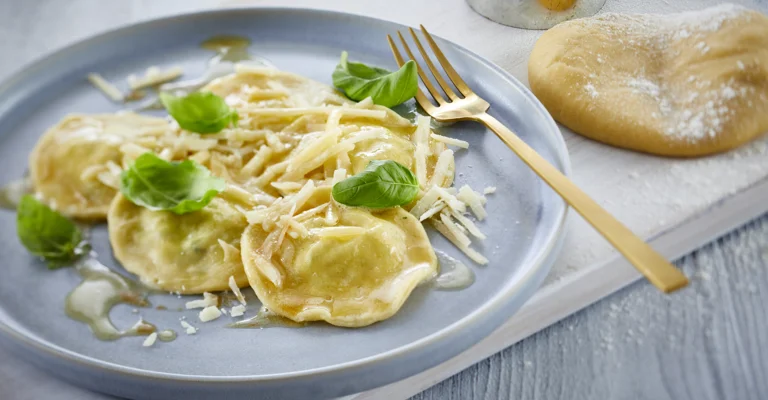


To keep your ravioli fresh, lightly dust them with semolina flour and cover with cling film before refrigerating. This will preserve them well for a few days. If you need to store them longer, arrange the ravioli on a baking sheet to freeze. Once solid, transfer them to a freezer-safe container, where they can be stored for up to six months. If you plan to use the ravioli within an hour, leave them at room temperature on a parchment-lined sheet pan, dusted with semolina, and covered with cling film. For usage within a few hours, you can refrigerate them for up to four hours. However, avoid leaving them in the fridge overnight, as this may cause them to become soggy and discolored.
To ensure that the filling stays put while cooking, press the pasta layers together to remove any air. Moisten the edges with water to create a stronger seal, and press firmly around the filling. This helps maintain the shape and prevent the filling from leaking as it cooks. For a more secure seal, use a dowel or the back of a spoon to press along the edges of the filling. With a bit of practice, your sealing technique will improve in no time.
Yes, it is possible to make ravioli without a pasta machine. Start by dusting a surface with flour, then use a rolling pin to roll the dough until it is thin enough to see the shadow of your hand through it. To simplify the process, work with smaller sections of dough and keep the unused portions covered to ensure they remain moist.
We offer a few helpful tips that can help you make the best homemade ravioli.
Roll out the dough as thinly as possible; the thinner the dough, the more delicate the ravioli will be. Ideally, the dough should be so thin that you can see your hand through it when it is rolled out to the proper thickness.
To prepare the desired ravioli filling, it is important to mix the ingredients well. Start by combining the cream cheese, pine nuts, and parsley thoroughly. Using a spatula or a wooden spoon, fold these components together until the mixture is homogeneous. This ensures that each bite of ravioli has an even distribution of flavors.
Roll out your dough on a flat surface and use a round cutter or the open end of a glass to cut out the pieces. Press down firmly with the cutter or glass, which should be dusted with flour to prevent sticking and to make clean, consistent cuts. That way, you can make sure that each ravioli cooks at the same rate.
Have you ever wondered how ravioli is made? We will tell you how it is done. These pretty little pockets of pasta are filled with a delicious filling and cooked to ideal tenderness. While making ravioli takes a bit of time, the steps involved are quite simple. It is a great opportunity to invite friends and family into the kitchen. Gather around to shape the ravioli by hand; it is a dish that is not just about enjoying great food but also about bringing people together.
The Italian kitchen has provided many different pasta recipes over the years. If you are looking for more ideas, try our recipe for Chicken Fettuccine Alfredo or Pesto Spaghetti. For a slight twist on ravioli, go for Crispy ravioli with tomato sauce.
The secret to great ravioli is good pasta dough. The ideal dough should be tender and delicate, thin enough to encase the filling neatly without overwhelming it. Once cooked, this dough transforms into smooth, small pillows, offering a tender texture that retains a slight bite and complements the rich and creamy filling.
Its filling combines creamy cheese with the crunch of pine nuts. Cream cheese is an excellent choice for a velvety-smooth base that is rich in flavor, while the pine nuts introduce a layer of complexity with their nutty, subtle sweetness. To add a fresh, herbaceous touch, we add finely chopped parsley. This ravioli filling is not only easy to prepare but also impressively refined.
Ravioli is a beloved staple in Italian cuisine and is cherished for the variety of fillings and flavors it can accommodate. This dish also fosters a sense of community and togetherness, as it invites people of all ages into the kitchen to enjoy the hands-on process of making ravioli from scratch. While the dish has traditionally been served for special occasions, it still works as an exciting and satisfying option for weeknight meals.
Serving homemade ravioli opens the door to a lovely dining experience, especially if you pair it with the right sides. A crisp arugula or romaine salad dressed lightly in a sharp vinaigrette offers a refreshing contrast to the rich, cheese-filled pasta. Enjoy ravioli all year round with a warm, garlicky loaf of ciabatta bread.
Choose simple sauces to accompany the ravioli, like browned butter or a drizzle of olive oil. It enhances the filling without overpowering it.
Experiment with various ravioli fillings to discover new flavors and textures. One tasty option is to mix ricotta cheese with Romano cheese, and egg. This mixture offers a rich, savory flavor paired with a creamy texture. You can also try a beef and spinach filling, which combines hearty, meaty flavors with the earthiness of greens. For a different taste, consider making ravioli with sweet Italian sausage, egg, and Parmesan cheese. Each of these options gives you the opportunity to explore the many diverse flavors that ravioli has to offer.

Fall in love with pasta all over again, as you serve your loved ones creamy dishes made richer with Puck—and your special touch. Our inspiring recipes, general guidelines, and detailed articles will set you on the path to culinary creativity. With Puck’s entire range of cooking creams and sauces that meet your high standards, you’ll love putting your personal spin on pasta.